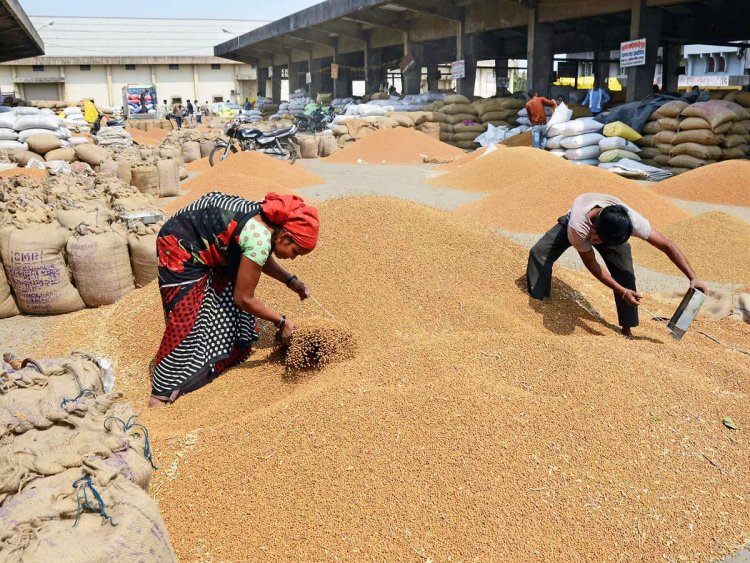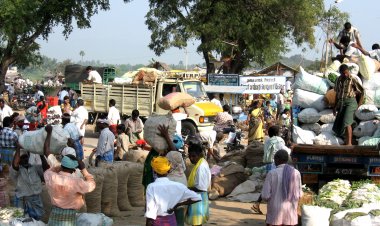Within the span of just a week, the central government released two important figures regarding wheat.
In the third advance estimates of the production of agricultural year 2022-23 released on May 25, 2023, the Ministry of Agriculture had said that this year a record 112.7 million tonnes of wheat has been produced, which is 5 million tonnes more than the previous year.
On the other hand, on June 1, 2023, the Food Ministry, while releasing the figures of government procurement of wheat, said that till May 30, 2023, the government procurement of wheat has reached 262 lakh tonnes.
It also said that as on June 1, 2023, there is a stock of 312 lakh tonnes of wheat in the central pool.
According to the data of the Food Corporation of India, the stock of wheat in the central pool as on June 1, 2022, was 311.42 lakh tonnes. That is, the stock of the central pool as on June 1 of last year and this year is almost the same.
Now the question is that when there is record production, then why wheat procurement has reached only 262 lakh tonnes against the target of 341.5 lakh tonnes?
Also, the prices of wheat in the market are running more than Rs 2125 per quintal fixed for the current Rabi marketing season (2023-24). In such a situation, the possibility of any significant increase in government procurement is now negligible.
In such a situation, questions may arise regarding the estimates of wheat production. The productivity of wheat was severely affected due to abnormal rise in temperature in mid-March last year. Farmers had said that their yield had fallen by 15 to 20 per cent in many places.
An important point is that last year the prices of wheat had increased very fast in the global market and it had reached up to $500 per tonne. Due to this, the export of wheat from India increased rapidly in 2021-22 and then in 2022-23.
Prices in the domestic market had gone above the MSP with the commencement of government procurement. As such, the government procurement was stuck at 187.92 lakh tonnes. That too when the government had banned the export of wheat on May 13, 2022.
Now let's talk about this year. The government sold wheat from the central pool on a large scale after the wheat price in December 2022 crossed Rs 3000 per quintal.
An announcement was made to sell 50 lakh tonnes of wheat under the Open Market Sale Scheme (OMSS). Out of this, about 34 lakh tonnes were sold till March. Also, the price under OMSS was brought below Rs 2,200 per quintal.
As a result, the prices of wheat in the market came close to the MSP of Rs 2125 per quintal for current rabi marketing season (2023-24).
In such a situation, despite a record production, the Government's procurement falling short of the target by 79.5 lakh tonnes raises questions. That too, when government officials kept making repeated statements that the ban on export of wheat would continue.
Although the government has procured more wheat than last year, there is not much of a difference between the stock as on June 1, 2023 and June 1, 2022.
The government has the same capacity to intervene in the event of a significant increase in prices in the open market as it did last year. It is a different matter that last year, the government had to allocate more rice instead of wheat under the Pradhan Mantri Garib Kalyan Anna Yojana in the last few months of the scheme and after that a new scheme was implemented by combining this scheme, in which five kilos of free food grains are given under National Food Security Act.
But at the time of PM Garib Kalyan Anna Yojana, five kg food grains were given for free and five kg food grains were given under the National Food Security Act, in which the price of wheat was two rupees per kg and the price of rice was three rupees per kg. In such a situation, if the government wants to increase the allocation for political gains in the election year, then it will be difficult for it in the case of wheat.
As far as the production is concerned, experts who made independent estimates last year said that the production was close to 90 to 95 million tonnes, which is the reason why prices increased despite the ban on exports.
This year too, wheat crop was damaged due to unseasonal rains in March and April and experts believe that there has been 10 to 30 per cent loss in the affected crop. On the other hand, if we go by the government data, despite the record production, the government procurement of wheat remained at 262 lakh tonnes, which is the lowest level from 2013-14 till date, except the abnormal government procurement last year (2022-23).
On the other hand, except for the last year in the central pool, the stock of wheat as on June 1, 2023 is the lowest level since June, 2015. However, there is a speculation that in the hope of better price, farmers have kept some stock of wheat with themselves instead of selling it in government procurement.
This may also be a factor in government procurement falling short of the target despite record production, but this will become clear from the movement of wheat prices in the coming days.




 Join the RuralVoice whatsapp group
Join the RuralVoice whatsapp group









































